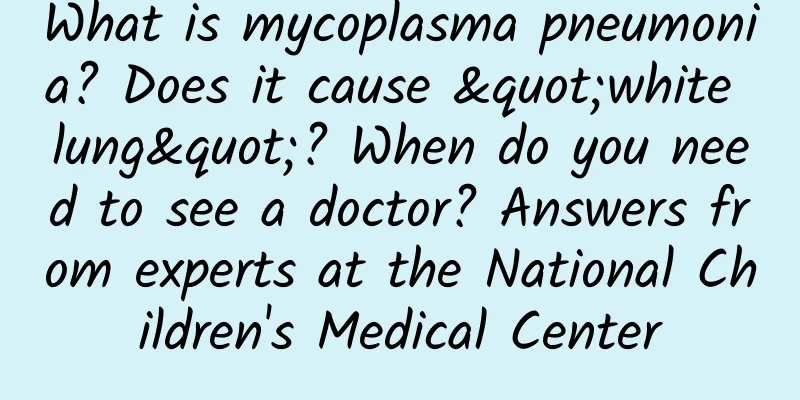What is mycoplasma pneumonia? Does it cause "white lung"? When do you need to see a doctor? Answers from experts at the National Children's Medical Center

|
Mycoplasma pneumonia has recently attracted widespread attention. What are the main symptoms? In what cases should you seek medical attention in a timely manner? How can you provide good home care? How can parents identify severe cases as early as possible? Xu Baoping, director of the First Respiratory Department of the National Children's Medical Center and Beijing Children's Hospital, answered these questions. Q: What is Mycoplasma pneumonia? What are the symptoms? Mycoplasma is a microorganism between viruses and bacteria and is a common pathogen in nature. Mycoplasma pneumoniae is one of them. Mycoplasma pneumoniae is mainly transmitted through respiratory droplets and can be carried in secretions from coughing, sneezing, and runny nose. The most typical symptoms of Mycoplasma pneumonia in children are fever and cough. The cough has certain characteristics. In the early stage, it is a paroxysmal, irritating dry cough. As the disease progresses, cough and sputum will appear. Some children with severe symptoms will experience wheezing, difficulty breathing, etc., so you should be highly vigilant and seek medical attention as soon as possible. Q: Will I definitely get pneumonia if I get infected with Mycoplasma pneumoniae? Will I develop “white lungs”? Infection with Mycoplasma pneumoniae does not necessarily cause pneumonia. Mycoplasma pneumonia can only occur when Mycoplasma pneumoniae invades our lower respiratory tract. Generally speaking, "white lung" refers to acute respiratory distress syndrome, which mainly occurs in severe infections. The disease is diffuse and progresses rapidly in both lungs. Its symptoms and severity are different from those of Mycoplasma pneumonia. Some children with mycoplasma pneumonia have a white patch on their lungs, which is mostly caused by infection in one lobe or one segment, mainly due to airway obstruction or inflammatory exudation in the lungs, but most of the other lobes are normal, which is different from the medical term "white lung". Children can be cured in a relatively short time through back patting, expectoration medication, bronchoscopy and other methods. Q: In what situations do children need to seek medical attention promptly? The course of mycoplasma pneumonia is related to the severity of the disease. Generally, mild pneumonia has a shorter course, while severe pneumonia has a longer course. The course of mycoplasma pneumonia is generally 2 to 4 weeks, and timely identification and early treatment are the key. There have been many respiratory infections of various types recently. If a child has a fever for 3 days, the temperature has not improved or the condition recurs, there is an obvious cough, increased respiratory rate, or accompanied by wheezing, difficulty breathing, cyanosis, headache, nausea, vomiting, diarrhea, rash, poor spirits, convulsions, etc., seek medical attention promptly. Q: How can parents identify severe Mycoplasma pneumonia? It is very important to detect severe and critical cases early to avoid serious consequences such as sequelae. If parents find that their children have any of the following conditions, they need to be highly vigilant and seek medical attention in time. ·Continued high fever (above 39°C) for ≥5 days or fever for ≥7 days, with no downward trend in the peak temperature. ·One of the following symptoms occurs: wheezing, shortness of breath, difficulty breathing, chest pain, hemoptysis, etc. Poor spirit, headache, convulsion, frequent vomiting, inability to eat, etc. Question: If a child is diagnosed with Mycoplasma pneumoniae infection, how can we provide good home care? Mild cases do not require hospitalization. The following points are recommended for home care: Ensure adequate rest and energy intake, and ensure water and electrolyte balance. It is not recommended that children who are infected or have symptoms such as fever, sore throat, runny nose, cough, etc. go to school while sick. Take antipyretics correctly. For children over six months old, you can choose ibuprofen or acetaminophen. You can choose one of them, no more than four times a day. However, you cannot take two antipyretics at the same time, and it is not recommended to use them alternately. If the child is over two months old and under six months old, only acetaminophen can be used. · Antitussive drugs are not routinely recommended. If the dry cough significantly affects the child's rest, it can be used as appropriate. Expectorants can be used, including oral and nebulized drugs, or percussion can be used to help children expel sputum. Pay attention to ventilation and keep clean. Children with allergies or family histories of allergies should avoid contact with tobacco, pets, flowers, etc. Families with many children should isolate themselves if possible to avoid cross-infection. Q: How to prevent Mycoplasma pneumonia? There is no vaccine for M. pneumoniae, but practicing good hygiene is important to avoid infection. Avoid crowded and poorly ventilated public places, and wear a mask when necessary. Cover your mouth and nose with a tissue when you cough or sneeze, and throw the used tissue into the trash. ·Keep your hands clean and wash them frequently with soap or hand sanitizer under running water. Pay attention to indoor ventilation, and ventilate for no less than 30 minutes each time to keep the air fresh. · Maintain good hygiene, wash bed sheets and blankets regularly, and dry them in the sun. · Eat a balanced diet, get enough sleep, and strengthen physical exercise to enhance your physical fitness and resistance. Schools, kindergartens and other places should ensure proper ventilation and disinfection to avoid clustered infections. |
<<: Why did the "butt injection" that was popular when we were young disappear?
Recommend
What is cheese? Is there a difference between cheese slices and cheese slices?
Cheese is a traditional food of Mongolians and Ka...
What causes vaginal itching and swollen labia?
In life, many women will encounter problems with ...
Can I eat instant noodles during my period?
Instant noodles are a favorite choice for many pe...
Why does vaginal bleeding occur during intercourse?
When a woman has sexual intercourse for the first...
What should I do if the abortion is not clean after the medication?
Women have always played a very important role in...
How to prevent low back and leg pain after childbirth?
The pregnancy and childbirth processes are both v...
What should I do if my period comes twice a month?
Irregular menstruation is a common gynecological ...
The difference between appendicitis and adnexitis
We have heard a lot about appendicitis, but have ...
How can women relieve lower abdominal pain after having sex?
Making love is the most enjoyable process for bot...
How to treat cleanliness IV degree
Because female friends may not pay much attention...
Can I do a vaginal ultrasound if I have bleeding?
In recent years, transvaginal ultrasound has basi...
In addition to the football breastfeeding position, you also need to know these
Breastfeeding plays a key role in the growth of n...
What to do if you can't sleep because of the itch down there
Women's vulva is prone to itching symptoms. V...
What are the red wines suitable for women?
Alcohol is really a two-sided thing. If you drink...









